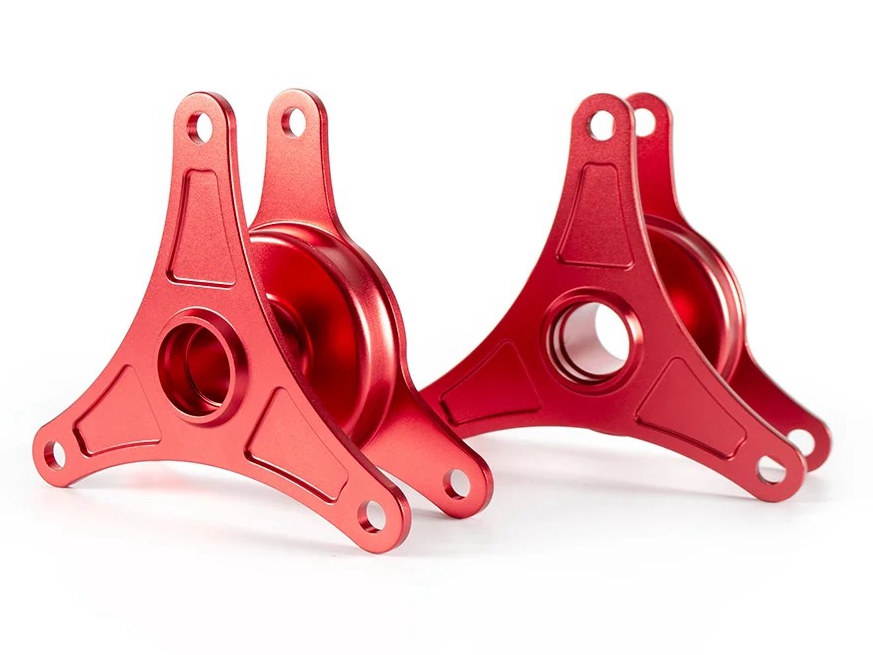Anodizing Explained: Boosting Corrosion Resistance for CNC Aluminum Parts
Introduction
Anodizing is an electrochemical surface treatment widely applied to CNC-machined aluminum components, creating a protective oxide layer typically between 5–30 μm thick. This controlled oxidation significantly improves aluminum’s corrosion resistance, wear resistance, and aesthetic appeal, enhancing part durability in challenging environments.
Anodizing is ideal for sectors like aerospace, automotive, and marine. It is fully compatible with complex CNC geometries, including intricate threads, thin walls, and precise features, making it indispensable for high-performance precision applications.
Anodizing Technology: Advanced Corrosion Protection through Surface Engineering
Scientific Principles & Industrial Standards
Definition: Anodizing is an electrolytic oxidation process performed in an acidic solution (typically sulfuric, chromic, or phosphoric acid), producing a controlled aluminum oxide film with precise thickness (5–30 µm, standard Type II; 30–100 µm, Type III hard anodizing).
Governing Standards:
MIL-A-8625: Anodic coatings for aluminum and aluminum alloys
ISO 7599: General specifications for decorative and protective anodizing
ASTM B580: Standard specification for anodic oxide coatings on aluminum
Process Function and Cases
Performance Dimension | Technical Parameters | Application Cases |
|---|---|---|
Corrosion Resistance | - 1,500–3,000 hours salt spray (ASTM B117) - Corrosion resistance pH 3–9 | Marine fittings, Automotive housings, Aerospace structural brackets |
Mechanical Durability | - Surface hardness: HV 200–600 (Type III) - Abrasion loss: <0.3 mm³/Nm (ASTM G65) | Hydraulic valve bodies, Precision sliding bearings, Motorcycle suspension components |
Electrical Insulation | - Breakdown voltage: 800–1500 V (20 µm film) - Resistivity: 10¹⁴–10¹⁶ Ω·cm | Electrical enclosures, Semiconductor equipment parts, HV electrical connectors |
Functional Aesthetics | - Colorfastness ≥8 (ISO 2135) - Consistent color range via organic dyeing | Consumer electronics casings, Luxury automotive trim, Architectural hardware |
Anodizing Process Classification
Technical Specification Matrix
Anodizing Type | Key Parameters & Metrics | Advantages | Limitations |
|---|---|---|---|
Type I Chromic Acid | - Thickness: 2–5 µm - Temperature: 32–40°C - Voltage: 20–40 V | - Minimal fatigue impact - Ideal for aerospace applications | - Limited corrosion protection - Environmental restrictions (chromium) |
Type II Sulfuric Acid | - Thickness: 5–30 µm - Temperature: 18–25°C - Voltage: 15–25 V | - Good corrosion resistance - Cost-effective - Color dyeing capability | - Moderate wear resistance - Thickness constraints |
Type III Hard Anodizing | - Thickness: 30–100 µm - Temperature: 0–5°C - Voltage: 25–100 V | - Exceptional abrasion resistance - High dielectric strength | - Higher processing cost - Complex dimensional control |
Selection Criteria & Optimization Guidelines
Type I (Chromic Acid Anodizing)
Selection Criteria: Optimal for aerospace or defense components requiring minimal dimensional change (<5 µm) and minimal fatigue reduction. Suitable where slight corrosion resistance is sufficient.
Optimization Guidelines:
Control bath temperature at 35°C±2°C for consistent film thickness
Post-process sealing in hot deionized water (96–100°C) for maximized corrosion protection
Monitor current density (0.5–1.0 A/dm²) for uniform anodic layers
Type II (Sulfuric Acid Anodizing)
Selection Criteria: Recommended for general industrial and decorative applications requiring medium corrosion protection (up to 3,000-hour salt spray). It is ideal when colored finishes are essential.
Optimization Guidelines:
Maintain electrolyte sulfuric acid concentration at 15–20 wt%
Use pulse-current techniques to reduce porosity and improve uniformity
Apply organic dyes post-anodizing for consistent coloration, followed by nickel-acetate sealing for enhanced durability
Type III (Hard Anodizing)
Selection Criteria: Essential for heavy-duty applications demanding superior hardness (HV 400–600), high wear resistance, and significant corrosion protection (over 3,000 hours ASTM B117).
Optimization Guidelines:
Precisely regulate low-temperature baths (0–5°C) for thick oxide films without defects
Adjust current density (2.0–4.0 A/dm²) to ensure even coating thickness
Perform precision grinding post-anodizing to achieve tight dimensional accuracy (±0.01mm)
Material-Coating Compatibility Chart
Substrate | Recommended Anodizing Type | Performance Gain | Industrial Validation Data |
|---|---|---|---|
Type III Hard Anodizing | +500% abrasion resistance | 10,000+ hours lifecycle in aerospace landing gear | |
Type I Chromic Acid | Minimized fatigue impact | FAA-certified aerospace structural components | |
Type II Sulfuric Acid | Enhanced corrosion resistance, aesthetic quality | Passed 1,500-hour salt spray for automotive housings | |
Type II with Dye & Seal | Superior decorative finishes & corrosion protection | 5-year outdoor exposure test compliant (ISO 2135 Grade 8+) | |
Type II Sulfuric Acid | Excellent formability & corrosion protection | Marine-grade validation: 2,000-hour salt spray performance |
Anodizing Process Control: Critical Steps & Standards
Pre-Treatment Essentials
Alkaline Cleaning: NaOH solution at 60°C (pH 10–12), ultrasonic agitation (10 min). Validation: Water-break test (ASTM F22).
Etching: Caustic soda etch (NaOH 40 g/L, 55°C, 2–5 min). Validation: Surface roughness Ra 0.8–1.2 µm (ISO 4287).
Deoxidizing: Nitric-acid-based solution (20–30 vol%, 2 min). Validation: Surface oxide removal was verified visually & chemically (ISO 8407).
Anodizing Process Controls
Thickness Control: Eddy-current probes (±5% accuracy). Validation: MIL-A-8625 compliance.
Bath Temperature: Automated thermostatic control ±0.5°C accuracy. Validation: Real-time sensor data logging.
Current Density: Rectifier with automatic feedback control (±1% current stability). Validation: Consistent thickness and uniform oxide growth.
Post-Coating Enhancement
Sealing: Nickel-acetate hot seal (96–100°C, 15 min). Validation: Dye fastness ≥8, sealed porosity <0.1% (ISO 2143).
Precision Finishing: CNC micro-polishing (Ra 0.1–0.2 µm). Validation: Surface roughness verified (ISO 25178).
FAQs
When should I choose Type II vs. Type III anodizing for my CNC aluminum components?
What’s the lifespan increase of anodized aluminum in marine and automotive environments?
Can complex geometries like internal threads and thin walls be effectively anodized?
How does anodizing compare to other coatings like powder coating or electroplating?
Are anodized aluminum parts suitable and safe for food processing and medical applications?

